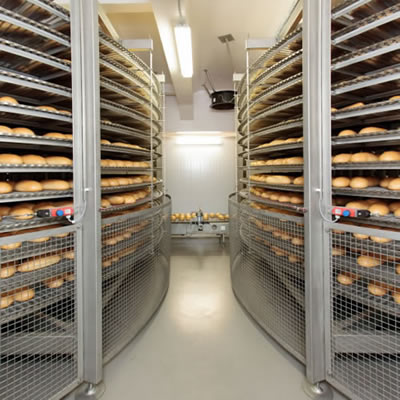
Bread Cooling
What is Bread Cooling?
Bread cooling is a crucial step in bread production. The main goal is to decrease the internal temperature of the baked bread from 93–97°C (200–208°F), at depanning or coming out of the oven, to 32–43°C (90–110°F). This step allows the finished product to achieve optimum keeping quality and comply with legal moisture limit of 38%.
Bread can be cooled either:
- Manually by placing on cooling racks after depanning (ambient or natural cooling)
- Automatically using racks, trays, or continuous conveyor belts (or spirals in wholesale breadmaking operations)
As the loaf cools, some of the moisture moves toward the crust which becomes softer or leathery unlike the hard shell it acquired in the oven. Cooled bread is immediately sliced, bagged or packaged.1
How does it work?
Bread cooling is a mass and heat transfer unit operation. During cooling, baked bread loses moisture and dries out due to differences in water content between the crumb (higher moisture content) and crust (lower moisture in exterior part that is exposed to convective cool air currents).2
This moisture gradient allows the water to escape (i.e. diffuse) as vapor from the product to the micro-atmosphere of the cooling equipment. This vapor can readily condense as a function of the dew point.
The temperature gradient, between product’s core (higher temperature) and cooling environment (lower temperature) causes the product to lose heat to the surroundings. This gradient is at its maximum at the end of baking and beginning of cooling, but decreases to reach zero with progressive cooling.2
Molecularly, cooling causes the amylose fraction of starch to retrograde, i.e. to re-crystallize almost completely in order to set the crumb texture. This transition is key and makes possible the bread slicing operation, a result of the loaf firmness and set shape without collapsing under the cutter’s mechanical action.3
Application
Bread cooling time is a function of the size and shape of the loaf as well as the oven baking profile. Denser and bigger pieces require longer cooling times (slowing conveyor speed while maintaining other cooling variables).
Cooling variables that require adequate control include:
- Cycle time (related to conveyor speed in continuous operations in spiral conveyor coolers)
- Relative humidity and temperature
- Air flow (convection cooling)
Food safety and sanitation considerations
Proper sanitation minimizes microbial contamination of bread and prevents the growth of mold, bacteria, and wild yeast in the packaging area. Since bread is sterile when it exits the oven, contamination occurs during cooling, slicing, and packaging.
Quality considerations
Inadequate cooling can negatively impact the quality of the baked product as well as the overall bakery operation. Effects of excessive or insufficient cooling include:
Excessive cooling (overcooling):
- The internal temperature is too low
- The finished product is drier and firmer with brittle, harsh eating qualities (crumbly)
- The dryness and loss of moisture contributes to a faster loaf staling
Insufficient cooling (undercooling):
- Bread sidewalls will be weak and may collapse while passing through the slicer
- Slices will be ragged and may tear due to excessive moisture remaining in the loaf and the crumb being too soft
- Gumming up of the slicer blades thus increasing downtime
- Pilling of the crumb
- Excess moisture due to condensation in the wrapper, thus encouraging mold growth
Vacuum cooling
Vacuum cooling is a relatively new technology which is characterized by its ability to reduce the difference between ambient atmospheric pressure and water vapour pressure. The vacuum system uses pumps which remove the gases and water vapour from the cooling chamber, creating a partial vacuum or zone of very low manometric pressure. This accelerates the vaporization of free moisture from the product.
Vacuum cooling is a rapid method that is suitable for products that are unstable and prone to collapse as they cool. Vacuum cooling allows bakeries to avoid the dependence on prevailing atmospheric conditions, achieving consistent results and uniform cooling at all times. Equipment required for this purpose must be isolated and sealed from the surrounding area and may be batch- or tunnel-type.3
References
- Stear, C.A. “Bread Cooling and Setting.” Handbook of Breadmaking Technology Elsevier Science Publishers Ltd., 1990, pp. 638–650.
- Cauvain, S.P. “Proving, Baking and Cooling.” Technology of Breadmaking, 3rd edition, Springer International Publishing Switzerland, 2015, pp. 147–176.
- Cauvain, S.P. “Bread and Other Fermented Products.” Baking Problems Solved, 2nd edition, Woodhead Publishing, Elsevier Ltd., 2017.

